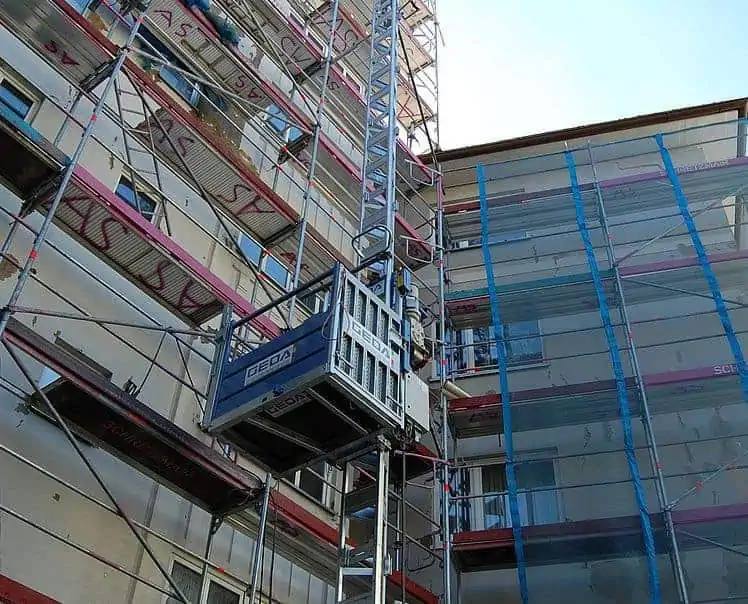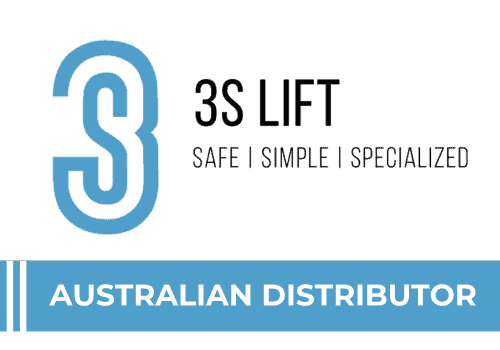Material hoists are compelling devices that allow you to lift heavy loads at a height on construction sites. However, they also pose potential hazards as the hoist and its load can cause damage if not handled properly.
The main hazard of hoists is failure under load, resulting in falling weights and splitting ropes. Also, if a person gets caught between a moving load and a fixed object, there is a risk of being pinched and injured. Several workers die at the construction work because of hoist hazards. It is such a big and robust machine that you can only control it if you follow the essential safety measures before using it.
This article will explore every safety factor you need to consider before using a material hoist on construction sites.
We will also discuss properly maintaining hoists to ensure they work before using them.

What is a material hoist?
Material hoists are devices that lift and move heavy materials upwards.
They consist of a motor, a gearbox, a drum or a sheave, and a lifting cable or chain.
The motor drives the gearbox, which rotates the drum or sheave.
The lifting cable or chain gets wound around the drum or sheave, and when it rotates, it lifts the load.
Hoists come in many types: electro-hydraulic, manual or lever operated, pedestal mounted, or overhead crane. Every kind of hoist has its benefits and cons, but the selection depends entirely on the job’s requirements.
Although these hoists operate differently, the precautions for working with them are similar.
Let’s learn the safety measures you need to take with material hoists.
What are the essential Safety Factors of Hoist Construction?
Before getting into exploring the safety factors of using material hoists, there are a few aspects you need to know in depth.
Make sure to gain proper knowledge of the design and the capacity rating of hoists to keep hazards at bay.
The hoist design –
The design of the construction hoists needs to be optimized to handle the maximum load it states. It may surprise you, but most hoists cannot lift the maximum loads they state.
And mostly, the design of the material hoists causes the most dangerous accidents at construction sites.
The Capacity Rating –
The capacity rating of a hoist is the maximum weight it can safely lift.
You must always check the capacity rating marked on the hoist and never exceed the load.
We also recommend loading the hoists beneath the maximum amount to avoid design failures in the middle of lifting.
If the hoist gets overloaded, it can cause the lifting cable or chain to break, resulting in serious injuries or even fatalities.
Lifting Cable or Chain
The lifting cable or chain is a critical hoist component and must be strong enough to handle the load.
You must regularly inspect the lifting chain to know the signs of wear and tear and replace it once it gets damaged or worn out.
Load Control device –
You must control the load at all times during the lifting operation.
The hoist needs to come with a load control device, like a load cell, to measure the weight of the load. The load control device must be calibrated regularly to ensure accuracy.
Pre-operational hoist safety practices that you need to follow
You must perform pre-operation inspection and preparation procedures to identify potential problems, prevent accidents, and improve the safety of the work environment.
- Daily checks
You must inspect the ropes, brakes, hooks, and limit switches for daily wear or damage to the material hoists.
Before operation
Before using the hoist, ensure that the top and bottom hooks rotate freely.
You must immediately replace damaged, worn, or corroded chains or wire ropes.
Tag any broken chains or ropes and remove them from service.
- Periodic checks
You must do periodic checks on the material hoists as recommended by the manufacturer or applicable law.
So, schedule a detailed inspection of all hoists operating daily in the construction sites.
Follow the maintenance schedule advised by the manufacturer.
Additionally, remember to replace any parts that need fixes.
Ensure safe rigging at all times.
Poor rigging and overloading are two vital causes of hoist failure in construction sites.
Follow the steps below to ensure safe rigging every time.
- When rigging, keep the load hook and upper suspension in line.
- Do not allow the hoist chain or body to contact the load.
- Always use slings for hoists to attach loads and use designed lifting points for attachment.
- Do not work under suspended loads or lift loads over people.
- Do not use material hoists to lift workers.
- After completing the work, install the hoist or hook so that it will not interfere with the movement of people or objects.
Use top-notch monitoring and overload protection systems.
Monitoring and overload protection systems prevent unnecessary accidents due to equipment misuse.
You need the best monitoring and overload protection system for the construction job, and they must match your equipment.
In addition, high-quality safety systems ensure the health of your employees and extend the service life of your costly devices.
Never stand under the hoists.
While the risks may seem obvious, it is still common for workers to step under loaded hoists.
You should refrain from doing this as there is a severe risk of hitting what you are lifting if something goes wrong. It is crucial always to maintain a safe distance from moving loads.
Never try to balance the load on the hoist manually.
Do not manually move or position the load to keep injury when using lifting
equipment, especially when moving at bay.
A well-designed hoist must adapt to any movement of materials and lift and position loads precisely.
So, always use the controls on the hoists to make the loading safe and accessible without overloading it.
Wear the necessary safety equipment always.
You must ensure to wear different types of PPE (personal protective equipment), including boots, gloves, helmets, and goggles.
Choosing the best one for specific needs requires evaluating and analyzing the working environment characteristics.
So, make sure the equipment you choose complies with applicable regulations.
Final Thoughts
People may be injured if the hoist’s mechanical parts move or objects fall or fly out. Body parts can also be caught or pinched between rollers, belts, chains, and pulley drives. Additionally, sharp corners and parts cause cuts and tears, and rough surfaces cause friction and wear. That’s why it’s important to know safety factors while using material hoists on construction sites.
Hoists are among the irreplaceable machines in any construction.
So, the usage of these machines will be more significant. However, following these safety factors, you can use hoists safely and efficiently and minimize the risk of accidents and injuries.



